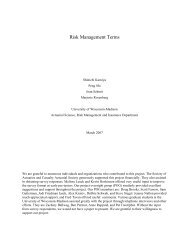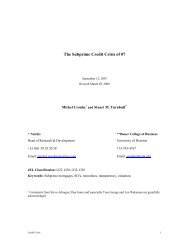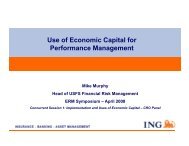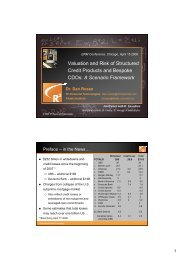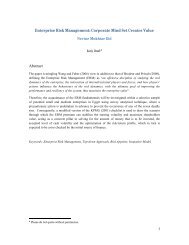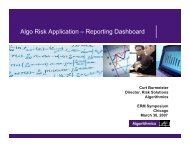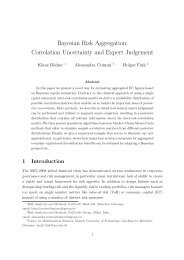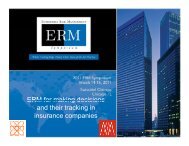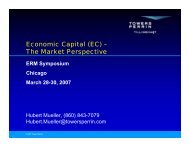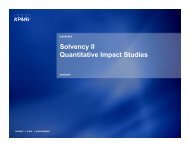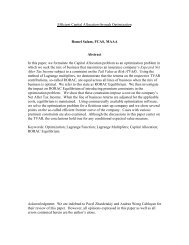An Empirical Map of Enterprise Risk Space for ... - ERM Symposium
An Empirical Map of Enterprise Risk Space for ... - ERM Symposium
An Empirical Map of Enterprise Risk Space for ... - ERM Symposium
You also want an ePaper? Increase the reach of your titles
YUMPU automatically turns print PDFs into web optimized ePapers that Google loves.
The third dimension (<strong>ERM</strong>3-RISK3) emphasizes asset risks on the <strong>Risk</strong> side and asset risk<br />
management tools on the <strong>ERM</strong> side. We find a recurrence <strong>of</strong> firms with illiquid private<br />
placements and asset risk overall on the high side <strong>of</strong> RISK3, together with size and sophistication<br />
on the high side <strong>of</strong> <strong>ERM</strong>3. But on the high end <strong>of</strong> RISK3, we also find firms with high overall<br />
asset risk and some product risk, together with low reserves. <strong>An</strong>d on the high side <strong>of</strong> <strong>ERM</strong>3, we<br />
add firms with significant asset allocation and reserve measures (product risk) coupled with low<br />
ALM <strong>for</strong> life products.<br />
The fourth and fifth dimensions each explain about 5% <strong>of</strong> the RISK-<strong>ERM</strong> interrelationship.<br />
Their interpretations are fairly straight<strong>for</strong>ward. The fourth dimension pairs asset risks with asset<br />
allocation and reserve strategies. The fifth relates reinsurance risks (assumed) with reinsurance<br />
tools (ceded).<br />
We emphasize that each canonical pair (dimension) <strong>of</strong> the interrelationship is orthogonal to<br />
every other pair and there<strong>for</strong>e provides a separate and distinct perspective on a different aspect <strong>of</strong><br />
the interrelationship. Together, these five dimensions explain about 93 percent <strong>of</strong> the<br />
interrelationship. To be sure, each side <strong>of</strong> the RISK-<strong>ERM</strong> interrelationship has been simplified<br />
through the selection <strong>of</strong> the most important factors on each side (14 <strong>for</strong> <strong>ERM</strong> and 18 <strong>for</strong> RISK).<br />
Conceivably, a different picture could emerge through the inclusion <strong>of</strong> more, or different,<br />
factors. However, the themes that emerge from the analysis are satisfyingly consistent. The<br />
theme <strong>of</strong> the most important dimension, <strong>ERM</strong>1-RISK1, is characterized by size, leverage and<br />
sophistication on the <strong>ERM</strong> side against high asset risk and low product risk. Insurers are placed<br />
along its risk dimension by their assumption (or not) <strong>of</strong> assets risks, and along its <strong>ERM</strong><br />
dimension by their employment <strong>of</strong> sophisticated tools, including derivatives. Insurers are also<br />
placed on a second dimension that represents a mix <strong>of</strong> product and asset risks and corresponding<br />
tools. The third and fourth dimensions correspond to different aspects <strong>of</strong> asset risks and tools.<br />
<strong>An</strong>d the fifth is a specific type <strong>of</strong> product risk and tool – reinsurance. Noteworthy is the presence<br />
on the <strong>ERM</strong> side <strong>of</strong> ALM tools <strong>for</strong> two <strong>of</strong> the 3 main products sold by this industry – life and<br />
health (ALM <strong>for</strong> annuities did not emerge in the relationship). Noticeable by its absence is any<br />
presence <strong>for</strong> operational risks (except in one factor) or tools. Although many operational risk<br />
25



